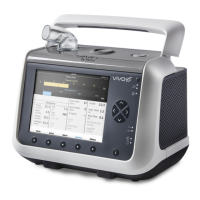5.3.19 EtCO
2
EtCO
2
displays the end-tidal carbon dioxide, measured on the last portion of the
exhaled volume that is passing through the EtCO
2
sensor.
5.3.20 InspCO
2
InspCO2 displays the inspired carbon dioxide.
5.3.21 PtcCO
2
PtcCO2 displays transcutaneous CO2 pressure from an external PtcCO2 monitor, if
connected by the PtcCO2 cable accessory.
5.4 Modes in the Vivo 45
In the Modes section of the Vivo 45 display, the operator selects the ventilation mode,
breath mode, patient mode and device mode for the treatment.
5.4.1 Standby and Operating Mode
Standby mode is defined as the state of the Vivo 45 when it is powered on but without
having treatment or pre-use test started.
Operating mode is defined as the state of the Vivo 45 when the blower is operating and
producing an air flow.
Switch between operating and standby mode by starting/stopping the ventilator (see 5.1
Switch the Vivo 45 On and Off, page 45).
Some operations (such as setting time and date) are only available in standby mode.
5.4.2 Device Mode
The two device modes of the ventilator are used for controlling the user access to the
ventilator settings.
Clinical mode allows full access to the ventilator treatment parameters for health care
professionals.
Home mode is used to limit the access to the ventilator’s settings for patients and lay
persons.
If the Home Adjust function is activated, the patient is given the possibility to change a
selection of patient parameters that is determined by the responsible care provider. The
limited settings for Home Mode are defined in the Setup section
See 5.2.3 Menu Overview, page 51 for a chart with settings available in the ventilator’s
Home Mode.
How to Use the Vivo 45 61
Doc. 006149 D-3
Vivo 45 User manual

